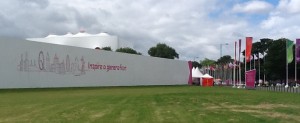
London 2012 promised that the Games would “inspire a generation”. During the Olympic and Paralympic Games we have been looking at what this means for sustainability.
I recently met with some of the team working on what LOCOG call “look and feel”, which includes everything from signage and way finding to all the banners throughout London and the messages that these are used to convey.
Some of the figures involved with this are quite remarkable. 100km of fence scrim (the material used to wrap a fence with) have been used. That’s enough to wrap a fence running all the way from the Olympic Park to the Channel Tunnel. 3,500 flags have also been used to display logos and messages aroundLondon and Olympic and Paralympic venues.
This got me thinking about the materials they are made from and what will happen to them post-Games. Maybe this makes me a ‘sustainability geek’ but someone has to think about these things! LOCOG have been thinking about it too. For example, they worked with their supplier to source alternatives to PVC and specified that that supplier to take everything back and recycle it. In some cases, they used a different material to ensure the banners and signs were more recyclable (for those fellow geeks out there, one example was using corex polypropylene instead of foamex for hard signs and banners).
Whilst the quantities used are substantial, they would have been higher if LOCOG hadn’t adopted the mantra “communicate, not decorate” and only placed “look” where they wanted people to look. Also, whilst there has been a change of materials from the Olympic Games to the Paralympic Games, only about 1/3 has changed through the swapping out of Olympic logos and replacing them with Paralympic logos. This is as opposed to a complete change. Of course, it would have been even better if only one London 2012 logo had been needed rather than having two versions but even here we have seen a step forward as LOCOG succeeded in getting both of the international committees (IOC and IPC) to agree to their respective logos being displayed side by side in some places. Hopefully we will see this integration continue for future Games so these wholesale changes become a thing of the past.
So, the look and feel is being made more sustainable but does it feel that way and will it inspire a generation? We have been asking visitors to the Games their thoughts on this. It’s been clear that people are noticing some of the key London 2012 sustainability features, in particular the parklands, the recycling provision, the micro wind turbines and the overall regeneration of the Stratford area. Whether those people are inspired to make their own behaviour more sustainable after the Games is still to be seen.
The “look and feel” aspect of the London 2012 Games didn’t set out to be overtly sustainable but various features of the biodiverse areas of the Olympic Park present their own message on this. Our Chair also wrote a recent blog about the unsung buildings in the Park – those that contribute a significant amount to the sustainability of the programme without necessarily being as well noticed. Perhaps there is actually a positive message here – that sustainability can be embedded without it necessarily having to be an obvious feature. But is this enough? Why don’t you leave a comment with your thoughts on this.
Jonathan Turner
September 2012
